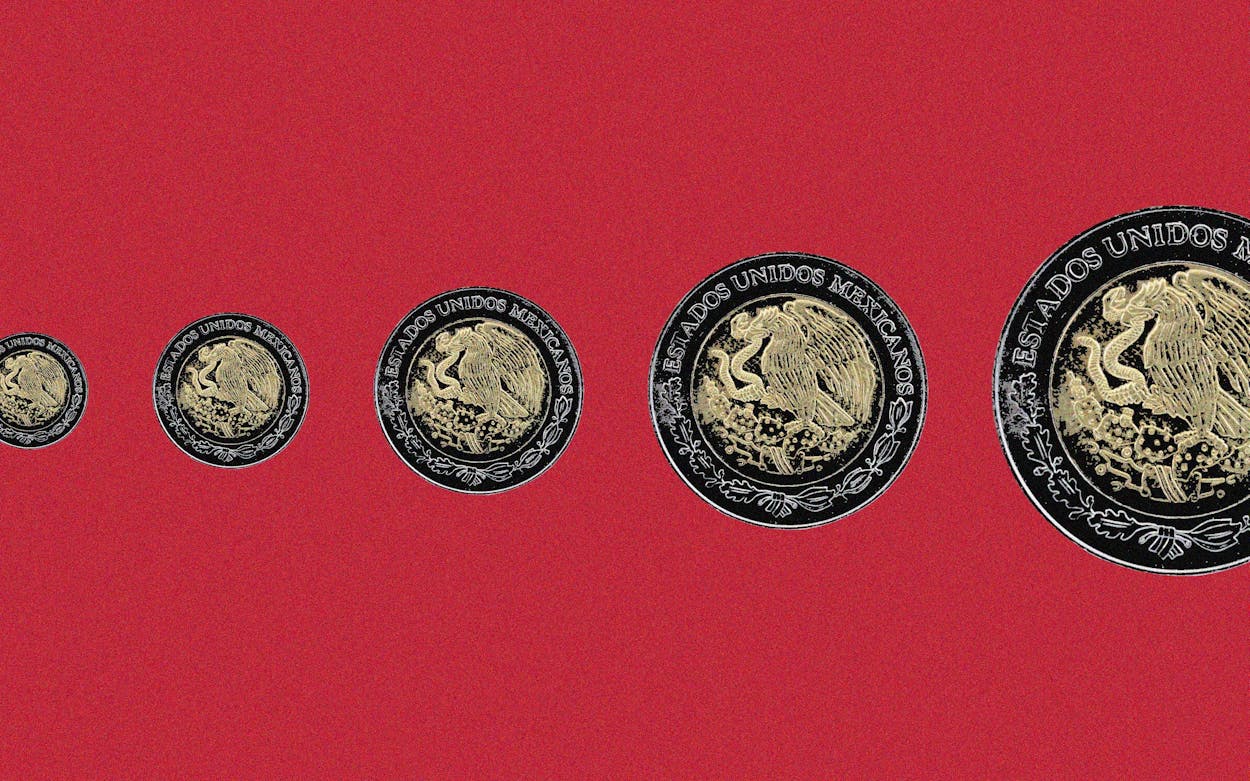Francisco Viramontes, who grew up in the West Texas border town of Presidio, used to do the bulk of his shopping in Mexico, where the cost of food and basic supplies was only a fraction of what it was in America. Even after he left his hometown to work in healthcare management at a facility near Odessa, he would regularly drive more than two hundred miles to Ojinaga, right across the border from Presidio, and leverage his dollars to shop for cheese, meat, and tortillas to take back home with him. Now, however, the value of the Mexican peso has sharply appreciated. Amid the early days of the pandemic, a dollar fetched an all-time high of around 25 pesos, and just a year ago it fetched 20. Now, it’s only worth around 17—which drives up prices for Viramontes and others shopping with greenbacks. “It’s not really worth the trip,” he said. “If I go, it’s just to visit family.”
For some, including Viramontes, the exchange rate is a deterrent to travel across the border. Many others, including Molly Ferguson Rodriguez, don’t have any other choice but to cross. It’s a common border tale: a family splits its time between the two countries. Rodriguez and her husband live in a house in Ojinaga but she works as the band teacher at Presidio’s middle and high schools. Her parents live in Presidio and she visits them frequently. Each time Rodriguez crosses over from Mexico, she has to pay a toll of 30 Mexican pesos. That used to be around $1.50 USD last year. Now it’s close to $1.80. When you live on a teacher’s salary, get paid in dollars, and cross as frequently as she does, Rodriguez said, the extra dimes add up.
While border residents are perhaps most immediately affected by the peso’s soaring value, the larger Texas economy may also see major consequences, both positive and negative. Mexico surpassed Canada and China as the top U.S. trading partner in 2023, and approximately 80 percent, or some $400 billion, of U.S.-Mexico trade crosses the border in the Lone Star State. The economies are so intertwined that Jesus Cañas, a senior business economist at the Federal Reserve Bank in Dallas, specializes in the Mexican economy and border economics. “We see Mexico as part of our region,” he said.
Texas Monthly spoke with economic experts on both sides of the border to better understand what’s happening to the Mexican currency and what effect the strong peso will have on tourism, cross-border trade, and more.
Why is the peso appreciating so much?
Mexico has become an attractive destination for those looking to invest in emerging economies where costs of labor, land, and other factors of production are lower than in, say, the United States, Europe, or Japan. Many emerging countries that used to be attractive to investors are becoming less so: Russia, because of the war in Ukraine, and China, because of geopolitical tensions. As the Biden administration has aggressively encouraged U.S. companies to shift manufacturing away from China and toward the U.S. and its allies, Mexico has been a beneficiary. Cañas noted that Mexico is particularly appealing because its macroeconomic conditions are sound: It’s an open-market economy with flexible exchange rates, its government finances are solid, and it enjoys proximity and low-tariff access to the huge, developed economies of the U.S. and Canada. As more and more investors build factories and warehouses in Mexico, hire locals to work in them, and pay the bills in pesos, the currency’s value appreciates.
Who will be most affected?
Broadly speaking, Texas exporters of products such as oil and gas, chemicals, plastics, and electronic components needed by Mexican factories will benefit, as will Texas businesses that benefit from increased spending by Mexican tourists and shoppers who now find Texas visits and products a relative bargain. Texas importers of everything from heavy trucks to fresh produce will be hurt, as will Texans visiting Mexico.
Also hurt by the strong peso are the millions of Mexicans who work abroad and send remittances home to their families. After India, Mexico is the second-biggest beneficiary of remittances from the United States, receiving more than $61 billion in the past year. Those who send money include undocumented migrants and temporary employees, many of whom labor in agriculture, construction, and the service industry, as well as legal residents and naturalized citizens with family members still in Mexico. The rising value of the peso means that American dollars won’t go as far for Mexicans who receive them.
Will it affect immigration?
The power of the peso is unlikely to tamp the flow of immigration from Mexico, because workers in the U.S. continue to earn much higher wages than those in Mexico, whether measured in dollars or pesos. However, if Mexico’s economy continues to grow rapidly, wages are likely to rise, and over time that might reduce migration, according to Jesus López, the deputy director of economic analysis at Banco Base, a Mexican financial firm.
Has it impacted tourism?
Tourism is a major engine of the economy in Mexico, accounting for nearly 9 percent of its income. Sixty percent of the country’s tourists come from the United States. However, while visits have increased in the last year, they still lag behind pre-pandemic levels, unlike other sectors of the Mexican economy, such as manufacturing and restaurants, which have fully rebounded. López says that while the declining value of the dollar versus the peso may be slowing the recovery of travel to Mexico, other factors such as widely publicized violence by drug cartels are also contributing.
Mexico also has a major stake in foreign travel to the United States. In 2021, 10.4 million Mexicans traveled to the United States, representing 47 percent of total foreign arrivals to the United States. The Texas Economic Development and Tourism office did not have any recent data on the impact of the peso surge on Mexican tourism in the state.
Will the “super peso” hurt U.S.-Mexican manufacturing? Will it boost U.S. factory jobs and exports?
It could have both of these effects, but has not done so yet. The United States and Mexico have what Cañas described as “complementary manufacturing systems,” wherein certain individual components of a complete product, such as a car, are manufactured in the U.S. while others are manufactured in Mexico at different stages of production. If it becomes more expensive to manufacture products of all sorts—vehicles but also medical equipment and electronics—in Mexico, that will hit our bottom line in the United States, said Cañas. However, he added the exchange rate would have to stay at its current level for an extended period of time before those costs were felt at the consumer level. So don’t worry: for now, the price of your favorite tequila won’t change much.
And although a stronger Mexican peso should favor exports to Mexico, including final manufactured goods such as vehicles, other factors have limited exports in the short term, said López. So far, in the first six months of 2023, even though the peso appreciated, Texas exports to Mexico actually fell by nearly 9.5 percent, or about $6.7 billion, from the first half of 2022. This is largely due to the reduction in prices of oil and gas, which is one of Texas’s top exports to Mexico.
López said that Texas employment may continue to grow, though likely not as a result of the strong Mexican peso. Reshoring is a stronger factor behind employment in the manufacturing sector.
How long will the peso stay strong?
“We expect the peso to continue relatively strong in front of the U.S. dollar,” said López, especially as interest rates in Mexico are expected to remain relatively high—a factor that tends to boost a country’s currency. Analysts estimate that the peso will close the year at around 18, lower than it is now, but higher than last year.
- More About:
- Politics & Policy
- Mexico








